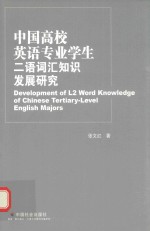
- 作 者:张文红著
- 出 版 社:北京:中国社会科学出版社
- 出版年份:2015
- ISBN:9787508751696
- 标注页数:204 页
- PDF页数:219 页
请阅读订购服务说明与试读!
订购服务说明
1、本站所有的书默认都是PDF格式,该格式图书只能阅读和打印,不能再次编辑。
2、除分上下册或者多册的情况下,一般PDF页数一定要大于标注页数才建议下单购买。【本资源219 ≥204页】
图书下载及付费说明
1、所有的电子图书为PDF格式,支持电脑、手机、平板等各类电子设备阅读;可以任意拷贝文件到不同的阅读设备里进行阅读。
2、电子图书在提交订单后一般半小时内处理完成,最晚48小时内处理完成。(非工作日购买会延迟)
3、所有的电子图书都是原书直接扫描方式制作而成。
Chapter 1 Introduction 1
1.1 Research background 1
1.1.1 Importance of vocabulary in L2 learning 1
1.1.2 Research of L2 vocabulary acquisition and major findings 3
1.1.3 Research of L2 vocabulary acquisition in Chinese context 4
1.2 Orientation of the present research 6
1.3 Organizatio of this book 9
Chapter 2 Literature Review 11
2.1 Previous theoretical explorations of word knowledge,vocabulary acquisition and development 11
2.1.1 Dimensional approach to word knowledge and vocabulary acquisition 12
2.1.2 Developmental approach to word knowledge and vocabulary acquisition 18
2.2 Studies on word knowledge assessment 27
2.2.1 Assessing vocabulary size 27
2.2.2 Assessing depth of word knowledge 39
2.3 Receptive and productive distinction of word knowledge 50
2.4 Empirical studies on word knowledge development within a word knowledge framework 51
2.5 Strengths and weaknesses in the previous empirical studies 55
2.6 Summary 56
Chapter 3 Design of the Empirical Study 58
3.1 Theoretical considerations for the present study 58
3.1.1 The theoretical framework for L2 word knowledge development 58
3.1.2 Rationale for the choice of the four types of word knowledge for investigation 60
3.1.3 Variables for investigation and their working definitions 64
3.2 Research design 67
3.2.1 Research questions 67
3.2.2 Research approach 68
3.2.3 Participants 69
3.3 Instrumentation 71
3.3.1 Instruments for the study 71
3.3.2 Pilot studies 74
3.4 Data collection 79
3.5 Data analysis 80
3.5.1 Norm setting and scoring scheme 80
3.5.2 Statistic techniques for data analysis 82
3.6 Summary 83
Chapter 4 Results of the Empirical Study 84
4.1 General results of the four tests 84
4.2 Results of test of vocabulary size 85
4.3 Results of tests for depth of word knowledge 88
4.3.1 Results of test of multiple meanings 89
4.3.2 Results of test of derivative forms 91
4.3.3 Results of test of near-synonyms 95
4.4 Interrelationships between the four types of word knowledge under investigation 99
4.5 Developmental patterns of vocabulary size and depth across the universities 102
4.5.1 Development of vocabulary size across the universities 103
4.5.2 Developmental patterns of depth of vocabulary across the universities 106
4.6 Summary 110
Chapter 5 Discussion 112
5.1 Issue of word frequency in the assessment of L2 vocabulary size 112
5.2 Vocabulary size for English majors at tertiary level 113
5.3 Word knowledge stabilization or fossilization 116
5.4 Lexical attrition 122
5.5 Incremental and dynamic nature of L2 vocabulary acquisition in classroom settings 131
5.6 Developmental route of L2 word knowledge in classroom settings 134
5.7 Summarry 137
Chapter 6 Conclusion 138
6.1 Major findings 138
6.2 Implications 139
6.2.1 Theoretical implications 139
6.2.2 Methodological implications 141
6.2.3 Pedagogical implications 142
6.3 Limitations of the present study 150
6.4 Suggestions for future research 153
Appendix 1 Vocabulary Size Test 154
Appendix 2 Test of Multiple Meanings 177
Appendix 3 Test of Derivative Forms 180
Appendix 4 Test of Near-Synonyms 181
Appendix 5 185
Appendix 6 186
Appendix 7 187
Appendix 8 188
Appendix 9 189
Appendix 10 190
Appendix 11 191
Bibliography 192
